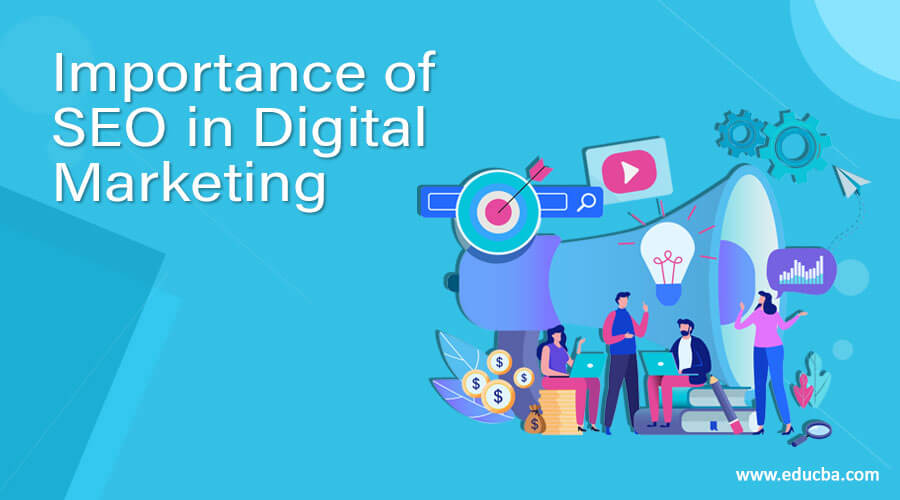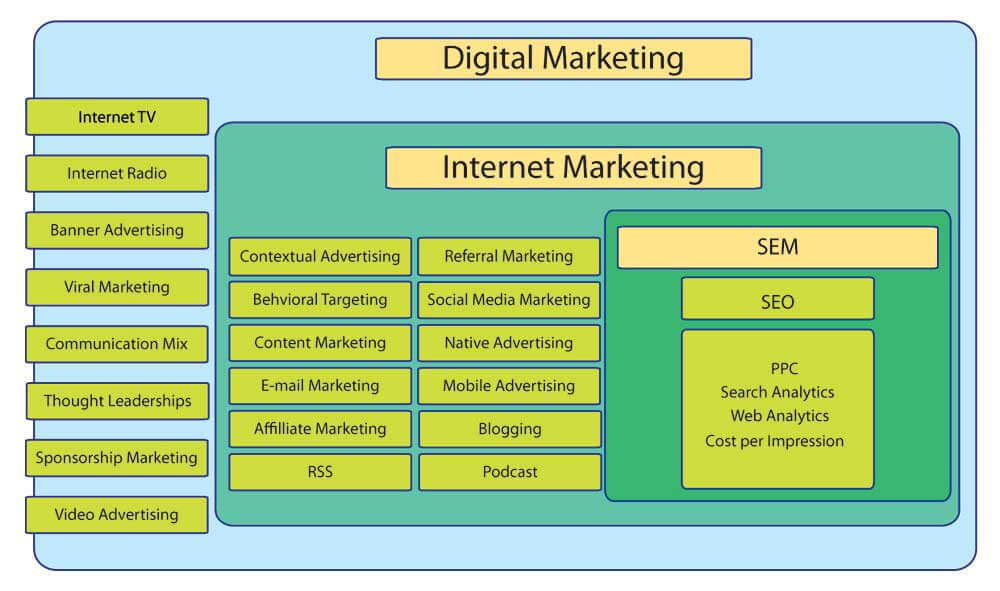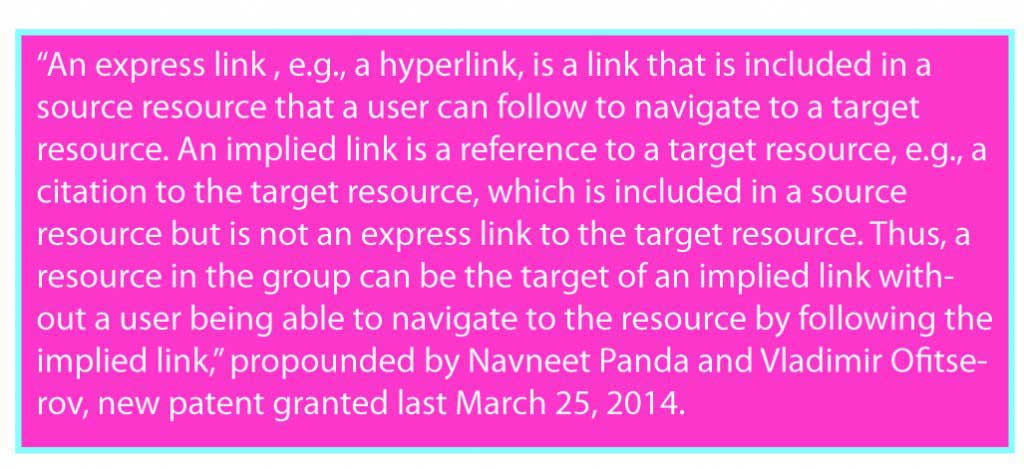Introduction to SEO in Digital Marketing
Just imagine having an outlet without having any signage on it – no name, no windows…nothing in particular. You would expect people may drop in out of curiosity, looking for product A, whereas you are selling product B. Now, when you have a shop with a proper name and probably the product image, this would attract so many people off the street. They would ask for what you sell, and some customers would tell other potential targets about their buying experience, your products, and your shops.
The first example describes a website that is not optimized, whereas the second example describes an optimized website.
SEO (Search engine optimization) is the process of making a web page easy to find, easy to crawl, and easy to categorize. It is about helping your customers discover your business from among thousands of other companies. SEO is an integral part of any digital marketing strategy. It is concerned with a holistic move towards driving customers to your business via online platforms. And to do that, one must ensure the website ranks higher in the SERP (search engine result page). To give you an idea of this, let’s start with SEO – nearly 14 billion online searches occur monthly. The advent of the Global economy provides almost every business with an online presence. Just imagine a fraction of those 14 billion searches happening for your business. To achieve that benchmark, your website must rank higher in the SERP and perform well in social media marketing. The PPC (pay-per-click) activities must be very well, along with other digital marketing tasks.
For any business, advertising is of utmost need. Advertising works best when any business goes online to garner a lot of web traffic. SEO allows a great deal of free advertising.
A proper SEO makes a website rank on the first page of SERP. And the common belief is people generally scan and review the first two pages of the SERP. Nearly 74% of consumers use search engines to find local business information. Compared to online marketing, such as PPC, social media marketing, and email marketing program, SEO provides fairly good ROI. Nearly 80-90% of customers check online reviews daily before purchasing products.
“SEO is a noun, verb, and adjective.” By Todd Malicoat
How does SEO work?
Search engines are not humans but software crawling web page content. So, not like humans, search engines are text-driven. They complete several activities that bring search results – crawling, scanning and storing (or indexing), courses of action, measuring pertinence, and recovering. The distinction with an excellence count is that you calculate design components rather than an individual’s actions. For example, some of the elements that are known to build up a quality score are as follows:
- Website names and URLs
- Page Content
- Meta tags
- Characteristics of Link
- Usability and accessibility
- Page design
Let’s see how this whole cycle works:
- Crawling: Every search engine has software, known as Crawler or Spider (in the case of Google, it is Googlebot), that crawls the webpage content. A crawler can’t see daily if any new page has appeared or if any existing page is updated; some crawlers may not visit a webpage for a month or two. In this connection, it should be essential to remember what all a search engine can crawl: it cannot crawl images, Flash Movies, JavaScript, Frames, Password protected pages, and directories. Therefore, if you have the majority of these on your website, it would be better to run a keyword simulator test to see if these are viewable by the spider. Those that are not viewable are not spidered, indexed, or processed. On the other hand, they will be missing from search engines.
- Indexing: Post-crawling content, the Spider stores the indexed page in a giant database from where those can be retrieved upon entering a related search string or keyword. This will not be possible for humans, but for search engines, this is every day’s work. Sometimes, search engines cannot understand the page content. And for that, you need to optimize the page correctly.
- Search work: With every search request, the search engine processes, i.e., it contrasts the key phrases searched with the pages indexed and stored in its record. More millions of pages have the exact search phrases. So, the search engine measures the relevancy of all the pages and matches with what it indexed as per the keywords inserted in the SERP.
- Algorithms: A search algorithm is a diagnostic means that takes a puzzle (when there is a search with a particular keyword), sorts through a record that contains cataloged keywords and the URLs that have relevancy with those keywords, estimates some probable answers, and then reverts pages that have the word or phrase that was looked for, either in the body content or in a URL that directs to the page. Three search algorithms are there – On-site, Off-site, and Whole-site algorithms.
- Each type of algorithm looks at different webpage aspects, such as Meta tags, title tags, links, keyword density, etc., yet they are all part of a much larger algorithm. That is why the exact search string generates different results in different search engines with distinct algorithms. And all these search engines (primary, secondary, and targeted) periodically keep changing their algorithms, so you must know how to adapt to these changes to stay on top. This requires sound SEO expertise.
- Retrieving: The end–the result will be visible in the search results.
SEO and Digital Marketing
There is no such difference between SEO and digital marketing approaches; both execute the same functions and possess the same skills. Only for marketing needs, different titles have been resorted. To understand this, we need to examine these concepts thoroughly. The below figure will clearly show how SEO is based as a subset of digital marketing.
The SEO people focus on bringing organic hits, while the digital marketers aim to establish a company’s online existence beyond SEO. In practice, an SEO consultant generally looks after other areas of digital marketing. And the whole SEO digital marketing service package may be named under SEO Packages since customers comprehend this more easily.
The contemporary trend includes more services, optimizing a website, and optimizing search engine marketing. For example, some factors take the help of SEO to select the right keywords, such as blogging with SEO content, contextual marketing, behavioral marketing, mobile advertising, Alt-texts in banner advertising, social media marketing, RSS, viral marketing, and video content advertising. And for that, a solid digital marketing and SEO strategies should be in place.
SEO – Integrated Digital Marketing
And after coming a long way, some marketing experts call SEO integrated digital marketing. Let’s give some light on this.
SEO is increasingly becoming important for the overall success of digital marketing. And we would get an excellent idea if we carefully watch the changing paradigm of SEO over the years. In the mid-’90s, when the first SEO came into the picture, manual submission, the Meta keywords tag, and keyword stuffing were all standard techniques necessary to rank well in the SERP. Then in 2004, to get web traffic, anchor text associated link bombing, link buying from automated blog comment spam injectors, and the creation of inter-linking websites took place. Then in 2011, social media marketing and vertical search inclusion became the mainstream SEO method. The search engine algorithms get updated time after time to bring traffic. The tactics used in 2004 are outdated, as the new call is something else.
Today, so many new memes change how an SEO consultant once worked though the basic understanding remains the same, such as title tags, H1 tags, and everyone’s preferred subject, thanks to Google links. Now, people consider many applications, previously deemed irrelevant to SEO, as essential factors to consider.
- Social Media: Social media marketing is gaining importance because of the increased usage of viral marketing approaches through Facebook, LinkedIn, Twitter, Yammer, and Google+. These social networking sites must align with the SEO best practices to entirely control SEO potential.
- More links to rank higher are not today’s approach: Personal reputation has become crucial. The old school of link building has some improvisations. The common belief of ranking high in the search results is changing – the content strategies are not the primary means, but generating the quality inbound links that stay as a much important SEO element to affect the ranking. The concept of ‘link’ is changing in that respect. The main idea behind traditional link building is to measure all the do-follow links a website can generate and ignore all no-follow links. The practice was to build as many links as possible. That system had drawbacks that some black-hat marketers banked on, and finally, Google changed its algorithms, which ended the traditional link-building practice. In the past, people used to refer to this practice as spamming. Nowadays, guest blogging with the sole intention of generating links is frowned upon. Guest blogging generates new audiences, presents yourself as an expert, and engages with your targeted community.
- The implied links factored in:
Implied linking is the term used to describe a situation where no direct link is back to the source site. Handling brand mentions and online citations carefully and seamlessly incorporating them into the site content using various techniques is essential. When creating content, brand mentions are typically connected to the products or services being discussed and explained about the content. Comments integrated into the content can also help achieve implied linking. Using the brand or website name creates a brand name or citation.
- Better judgment in brand authority: Google does not give that much importance to the former practice of traditional link building. A new brand authority will rule in the form of brand mentions.
- There is no manipulation: The Anchor texts and links cannot be manipulated now. Brand mentions or online citations have replaced the black-hat practice of linking to entirely unrelated sites from the source site. After flawlessly weaving a brand into site content, any implied links should point to relevant sites.
- Influencing social signals through brand mentions: People consider brand mentions or online citations essential for leveraging social signals in SEO. Sharing, commenting, tweeting, or citing source content socially, with or without links, can still help to improve the website’s ranking, even though the links generated through social media are no-follow and do not affect SERP rankings. Social media optimization is the process of back-linking through social media, which helps to funnel content to the highest rankings.
- Online citation is an important factor for local SEO: Local SEO targets potential customers of small and medium-sized enterprises. Citations are always good for local SEO. Google considers using your name, address, and contact number to form a bigger picture.
- The balance between traditional linking and brand mentions: You should not develop the wrong notion that only brand mentions exist nowadays and that traditional linking has become obsolete. There needs to be a balance between these two. Equal importance must be given. Below is a balanced link-building strategy between implied and express links:
- To avoid the risk of spamming that can harm your brand, it is important to avoid having a higher ratio of exact match links to your brand mentions.
- Google likes viral visual content as it is the right way to keep a good ratio of express links to brand mention.
- You can promote your brand by using guest blogging.
- Link building strategy needs to be as fair and usual as possible.
- Use every avenue to teach the brand mentions – social media, guest blogging, comments, and RSS feeds that can go viral.
- Last but not least, prepare your website by thinking about your target audience – what they deserve. Relevant and valuable content must flow in.
- Social media optimization has a new entrant, video optimization: Today’s SEO expert knows how to optimize video content, effectively distribute it, and measure its efficacies in meaningful ways.
- Paid search redefined: A co-optimization plan needs to follow the paid search initiatives with a high degree of group effort with the organic search team for the utmost outcomes on both sides of the aisle.
- Use of data: Another critical parameter is the capability to understand, mine, and use data efficiently to steer strategy and sharing of resources within a restricted budget for the highest ROI (return on investment).
- Miscellaneous factors of modern SEO: The most crucial search engines consider the bounce rate, site speed, and content above the fold as significant factors in their algorithms. Also, display advertising, including behavioral targeting or retargeted marketing and contextual advertising, use the targeted keywords generated in the organic search practices. Most of all, you all need a thorough idea of the marketing campaigns and business model to work in evocative ways.
Create an SEO Strategy
It would be best if you had a good SEO strategy to have a sound SEO system. Below are some points you need to ask yourself while setting an SEO strategy:
- Your target market: The purpose of SEO is not just to drive as much web traffic as possible to sell your items. Some geographic conditions and customer demographics are essential for where and how you will get your customers. Fine-tuning these parts will make you confident and successful in the future. Google Analytics will help you in your investigations of these factors.
- Concentrate on mobile-friendly approaches: Your website should fit properly on mobile and give your customers equal satisfaction with how they access your site on their personal computers. One thing is clear; mobile overtakes the desktop. So, open that lane by checking how your website performs on mobile applications. Test your website URL in Google’s Mobile-Friendly test for this.
- More options in Search Engines: Your website should be not only perform well on Google but in every other search engine like Yahoo, MSN, AOL, and DuckDuckGo. Each search engine has different search algorithms that you need to know and accordingly make your website compatible with these searches. Your users may come from any road.
- Keywords to correspond with your ROI: Spend time on fixing relevant keywords. Please focus on the Long Tail keyword as it defines users’ behaviors. Meticulously think about you can frame long tail qualities into your key phrases. To measure the success of keywords, it is important to consider the ROI (return on investment).
- Clear website and quality content: A user-friendly website, clear navigation, SEO keywords, optimized Meta tags, title tags, and balanced keyword density in the qualitative, relevant, and consistent content are the main aims. Building each page around keyword themes and using unique, non-plagiarized content is essential when creating each page. There should be no keyword stuffing as well. “Content is a commitment, not a campaign.”
- Quality and relevant linking and Social media: You must pay good attention to building quality and relevant links through which you can get a good number of web traffic. And in line with SEO, you need to set up an exhaustive and up-to-date social media platform. Remember that your business’s social media presence generates significant traffic.
Conclusion
Every time the algorithms change, they give challenges in front of you. You should not forget that no static SEO system will stay forever, as “SEO is a never-ending process.” With changing online customer behavior, search engines, too, have developed different policies. But you are to realistically think about your target audience, their preferences and dislikes, the usability of the website, and well-thought optimization plans. Some may think only about ranking in the SERP without even bothering about their users. After indexing the content, the Spiders will note its quality and relevance. If it finds some dishonest means taken to rank in the search results, it will surely spam it, and in dire cases, the search engines will ban your website. Therefore, the main task is to think about your users first, how they navigate your site, and their satisfaction with using your website; this would directly affect the site’s popularity or the time spent on each page.
And all these considerations make SEO a great deal of work. You have to schedule daily time into your routine for the SEO attempt.
When incorporating SEO tasks into an already-built website, it is crucial to prioritize the website and optimize it properly, ensuring all elements are covered along the way, whether by yourself or with the help of an expert or an SEO agency.
After incorporating all of these elements and implementing a balanced SEO strategy, your digital marketing plan will undoubtedly succeed in gaining the attention of your target audience.
Recommended Articles
This is a guide to SEO in Digital Marketing. Here we have discussed the basic concept, how it works, and some points you need to ask yourself while setting an SEO strategy. You can also go through our other suggested articles to learn more –






